No edit summary |
No edit summary |
||
| Line 6: | Line 6: | ||
== Background == | == Background == | ||
Y-Hacker News,"[https://news.ycombinator.com/item?id=22453100 Open-Source "pandemic ventilator]", 2020. | |||
* Drugs and expertise are required along with the use of a ventilator. | |||
* https://panvent.blogspot.com/ | * Clincal and professional care is required to use a ventilator safely. It is a risk to use a homemade ventilator at home due to clogging of fluids. | ||
* https://www.reddit.com/r/medicine/comments/fgmsrh/open_source_crowd_sourced_medical_ventilator/ | |||
* https://hackaday.com/2020/03/12/ultimate-medical-hackathon-how-fast-can-we-design-and-deploy-an-open-source-ventilator/ | Dreamer, "[https://panvent.blogspot.com/ Pandemic Ventilator Project]", 2020 March 28. | ||
* https://coronavirustechhandbook.com/hardware | * Must be able to manually control the peak inspiratory pressure (PIP), tidal volume, inspiration to expiration ratio (i:e), breathes per minute (BPM), and peak end-expiratory pressure (PEEP). | ||
* [[File: dreamer_schematic.jpg|thumb|center|The schematic for this open-source ventilator]] | |||
Reddit, "[https://www.reddit.com/r/medicine/comments/fgmsrh/open_source_crowd_sourced_medical_ventilator/ Open Source Crowd Sourced Medical Ventilator]", 2020. | |||
* Possible short term solution would be connecting multiple patients to a single ventilator that would allow for adjustments of the PIP value. This is complicated when considering pandemics such as COVID-19. | |||
* First single-use ventilator: https://mms.mckesson.com/product/1115066/Hartwell-Medical-SV2131B ('''not advised for use'''). | |||
Gerrit Coetzee, "[https://hackaday.com/2020/03/12/ultimate-medical-hackathon-how-fast-can-we-design-and-deploy-an-open-source-ventilator/ ULTIMATE MEDICAL HACKATHON: HOW FAST CAN WE DESIGN AND DEPLOY AN OPEN SOURCE VENTILATOR?]", 2020 March 12. | |||
* The problem with creating an open source ventilator is the decision of what kind of respirator is needed (CPAP, BIPAP, Hi-Flo oxygen NIV). | |||
* A Nasal cannula-based NIV would be needed for ventilators specific to COVID-19. | |||
Coronavirus Tech Hanbook, "[https://coronavirustechhandbook.com/hardware Other Hardware]", 2020. | |||
*Document that has numerous references for COVID-19. | |||
* https://boingboing.net/2020/03/14/fb-group-forms-to-open-source.html | * https://boingboing.net/2020/03/14/fb-group-forms-to-open-source.html | ||
* [https://docs.google.com/document/d/15kqUPPI7bYL6dnCetOeDSyE8IG5pHVmtg8Ju4yzGlF8/edit?fbclid=IwAR1phvwAhy_p-5pJl0PK2IgNb1G3B8wS3qdjOFPCgoVSCaMSDwOJv01LUWM Open-Source COVID19 Medical Supplies Requirements] | * [https://docs.google.com/document/d/15kqUPPI7bYL6dnCetOeDSyE8IG5pHVmtg8Ju4yzGlF8/edit?fbclid=IwAR1phvwAhy_p-5pJl0PK2IgNb1G3B8wS3qdjOFPCgoVSCaMSDwOJv01LUWM Open-Source COVID19 Medical Supplies Requirements] | ||
* [https://www.3dprintingmedia.network/covid-19-3d-printed-valve-for-reanimation-device/ example 3d printed valve] | * [https://www.3dprintingmedia.network/covid-19-3d-printed-valve-for-reanimation-device/ example 3d printed valve] | ||
Revision as of 20:10, 4 April 2020
Over the rest of the semester MOST and well as the MTU Open Source Hardware Enterprise will be documenting, building and testing open source ventilators. If you want to help please do.
- Pearce JM. A review of open source ventilators for COVID-19 and future pandemics. F1000Research 2020, 9:218 (https://doi.org/10.12688/f1000research.22942.1) academia open access
Background
Y-Hacker News,"Open-Source "pandemic ventilator", 2020.
- Drugs and expertise are required along with the use of a ventilator.
- Clincal and professional care is required to use a ventilator safely. It is a risk to use a homemade ventilator at home due to clogging of fluids.
Dreamer, "Pandemic Ventilator Project", 2020 March 28.
- Must be able to manually control the peak inspiratory pressure (PIP), tidal volume, inspiration to expiration ratio (i:e), breathes per minute (BPM), and peak end-expiratory pressure (PEEP).
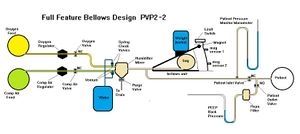
The schematic for this open-source ventilator
Reddit, "Open Source Crowd Sourced Medical Ventilator", 2020.
- Possible short term solution would be connecting multiple patients to a single ventilator that would allow for adjustments of the PIP value. This is complicated when considering pandemics such as COVID-19.
- First single-use ventilator: https://mms.mckesson.com/product/1115066/Hartwell-Medical-SV2131B (not advised for use).
Gerrit Coetzee, "ULTIMATE MEDICAL HACKATHON: HOW FAST CAN WE DESIGN AND DEPLOY AN OPEN SOURCE VENTILATOR?", 2020 March 12.
- The problem with creating an open source ventilator is the decision of what kind of respirator is needed (CPAP, BIPAP, Hi-Flo oxygen NIV).
- A Nasal cannula-based NIV would be needed for ventilators specific to COVID-19.
Coronavirus Tech Hanbook, "Other Hardware", 2020.
- Document that has numerous references for COVID-19.
- Open-Source COVID19 Medical Supplies Requirements
- example 3d printed valve
- https://foro.coronavirusmakers.org/
- https://medium.com/frontier-technology-livestreaming/frontier-tech-4-covid-action-emerging-market-ventilation-systems-9c818cb46189
- https://assets.publishing.service.gov.uk/government/uploads/system/uploads/attachment_data/file/874279/RMVS001_Rapidly_Manufactured_Ventilator_Specification__PDF.pdf
- https://www.agorize.com/en/challenges/code-life-challenge?lang=en
How Many are Needed?
See Dave Denkenbergers' spreadsheet
- https://www.youtube.com/watch?v=jmUMolg-7nA
- https://www.nytimes.com/2020/03/13/us/coronavirus-deaths-estimate.html
- https://www.politico.com/news/2020/03/14/health-system-coronavirus-preparation-129066
- https://www.npr.org/sections/health-shots/2020/03/14/815675678/as-the-pandemic-spreads-will-there-be-enough-ventilators
- https://abcnews.go.com/Health/demand-ventilators-spikes-coronavirus-looms/story?id=69597233
- https://www.nytimes.com/2020/03/12/opinion/coronavirus-hospital-shortage.html
- FDA sweeping away regulations https://www.precisionvaccinations.com/continuous-positive-airway-pressure-cpap-machines-enhance-people-respiratory-challenges ,
Existing Designs
- https://github.com/PubInv/covid19-vent-list -- the list now updated daily
- https://www.instructables.com/id/The-Pandemic-Ventilator/
- https://www.appropedia.org/Negative_pressure_respirator
- https://app.jogl.io/project/121#about and https://www.projectopenair.org/ and the core documentation on the ventilator project https://drive.google.com/drive/folders/1TrHL40-RwSL_yWivaRF8GyKmLVJMr63j
- https://www.medonegroup.com/pdf/manuals/techManuals/Cardinal-Health-VELA-Ventilator-Service-Manual.pdf Service Manual for a Commercial Ventilator
- https://www.cbc.ca/news/canada/london/pandemic-ventilator-coronvirus-hospitals-1.5493830
- https://onlinelibrary.wiley.com/doi/full/10.1111/j.1365-2044.2009.06207.x
- https://www.oxygen.protofy.xyz/
- https://e-vent.mit.edu/
- https://gitlab.com/open-source-ventilator/OpenLung
- https://simulation.health.ufl.edu/technology-development/open-source-ventilator-project/
MTU Designs
Open Source Ventilator
- Details currently in progress
Innovative Global Solutions (IGS) Enterprise
IGS enterprise has given their focus to constructing three versions of a pandemic ventilator throughout the past few years. These specifications were given for use of either rebuilding the machine to be used during the COVID-19 outbreak, or taking key components to use in the open source ventilator (see above). This ventilator had achieved a price tag of below 2000 USD, the most expensive component being the compressor.
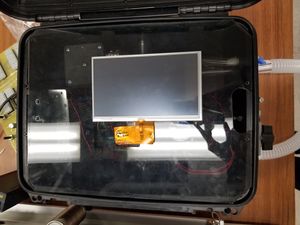
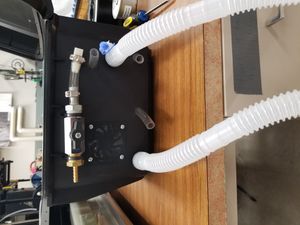
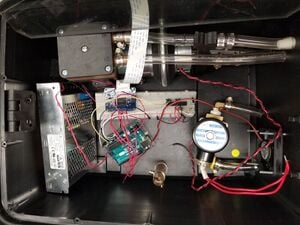
Testing Procedures
- https://www.gov.uk/government/publications/specification-for-ventilators-to-be-used-in-uk-hospitals-during-the-coronavirus-covid-19-outbreak
- https://github.com/PubInv/ventmon-ventilator-inline-test-monitor
- ISO 80601-2-12 https://www.iso.org/standard/72069.html
- MDSR Minimum Requirements: http://www.mdsr.ecri.org/summary/detail.aspx?doc_id=8305
MTU Testing Procedure
- Select on of the four modes using the user interface on the ventilator (for the IGS ventilator):
*Continuous mechanical ventilation (CMV): used when a patient is not breathing on their own *Inverse ratio ventilation (IRV): used when a patients inhale lasts longer than their exhales(i.e 2:1 instead of 1:2) *Pressure support ventilation (PSV): when a patient has trouble completing a breath thus resulting in negative pressure during a breathing circuit *Assist Control (AC): used when a patient needs support for every breath
- Confirm that the peak inspiratory pressure (PIP), respiratory rate (RR), positive end expiratory pressure (PEEP), inspiratroy:expiratory ration (i:e), and tidal volume (TV) are accurate by using the Michigan Instruments software package that accompanies the lung (downloaded in the MI USB drive).
- Test the alarms by unplugging the machine, wiring, and appropriate tubing. The accessories that should be tested are:
*Low Pressure Alarm: Decrease the PIP value using the ventilators user interface to an abnormal value. *High Pressure Alarm: Increase the PIP value using the ventilators user interface to an abnormal value. *Oxygen Concentration Alarm: Increase/decrease the percentage of oxygen per breathe to above/below the safety range (19.5-23.5%) by mechanically increasing/decreasing the amount of O2 entering the ventilator and using an O2 sensor. *Battery Backup Alarm: Unplug the ventilator's primary battery from the voltage source. *Wire Disconnection Alarm: Unplug a wire from the circuit board in the ventilator while it is running. *Oxygen Tube Disconnection Alarm: Unplug the oxygen intake tube from the ventilator while the machine is on. *Mechanical Failure/Fatigue (# of cycles): Leave the machine running for extended periods of time (a few hours, days, weeks) and observe any inaccuracies.
- Ideal Values that Should be Targeted for a Healthy Patient:
*PIP: 10-14 cm H2O *RR: 8-12 breathes per minute (BPM)
*PEEP: 3-10 cm H2O
*I:E: 1:2
*TV: 6-8 mL/kg
*O2 Concentration: 19.5-23.5%
*FiO2: 1.0 (100%)
* Mechanical Failure/Fatigue (# of cycles): ideally for as long as the patient requires the use of the ventilation
Regulations
- FDA's activities regarding medical devices: https://www.fda.gov/medical-devices
*COVID-19 activities: https://www.fda.gov/emergency-preparedness-and-response/coronavirus-disease-2019-covid-19/covid-19-related-guidance-documents-industry-fda-staff-and-other-stakeholders
- Policy for ventilators: https://www.fda.gov/media/136318/download
- Emergency Use Authorization: https://www.fda.gov/emergency-preparedness-and-response/mcm-legal-regulatory-and-policy-framework/emergency-use-authorization
* A ventilator would fall under other medical devices: https://www.fda.gov/emergency-preparedness-and-response/mcm-legal-regulatory-and-policy-framework/emergency-use-authorization#covidothermeddev
- FDA’s enforcement policy for certain modifications to ventilators and accessories and other respiratory devices during COVID-19: https://www.fda.gov/media/136318/download
- Importation of a medical device: https://content.govdelivery.com/bulletins/gd/USDHSCBP-282c648?wgt_ref=USDHSCBP_WIDGET_2?utm_source=csms.cbp.gov&utm_medium=csms.cbp.gov&utm_term=undefined&utm_content=undefined&utm_campaign=(not%20set)&gclid=undefined&dclid=undefined&GAID=1278996374.1567630590
Safety Precautions
- Confirm that the wiring in the ventilator is correctly set-up (see wiring diagram)
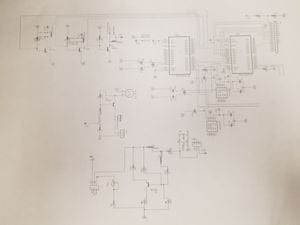
- Make sure that the ventilator is properly connected to the artificial lung with the proper adapter size (see picture below)
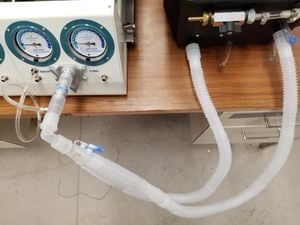
- Confirm that the artificial lung is set-up correctly BEFORE turning the machine on (see manual below, pg.11)
https://www.michiganinstruments.com/wp-content/uploads/2018/11/TTL3OpsManualREV2017-05.pdf

